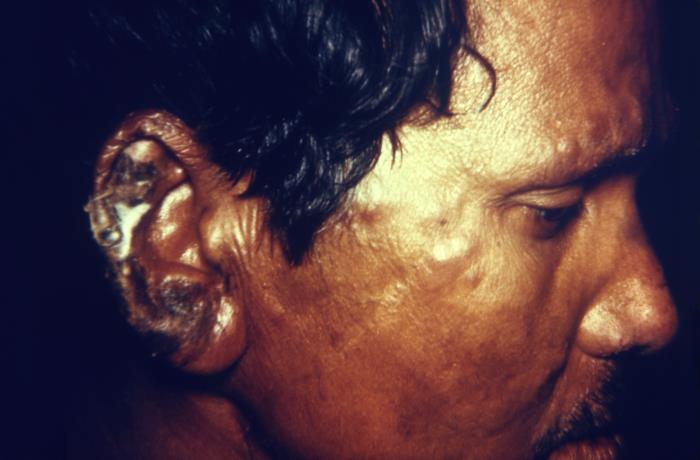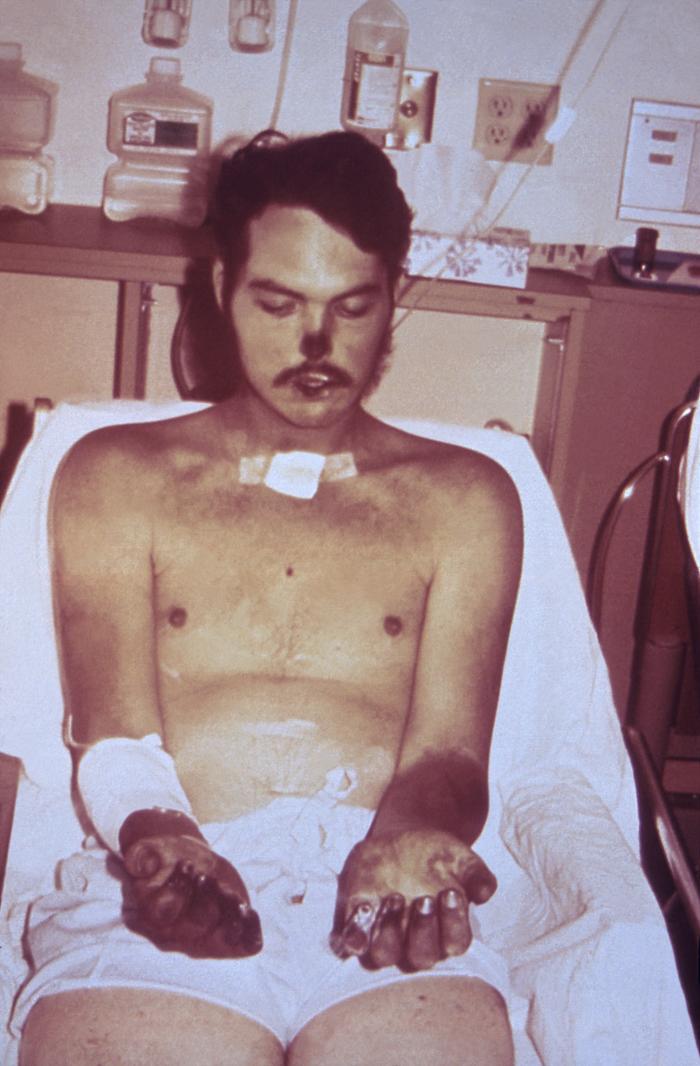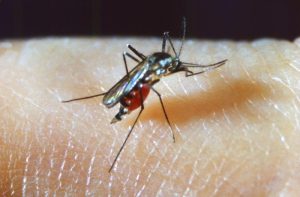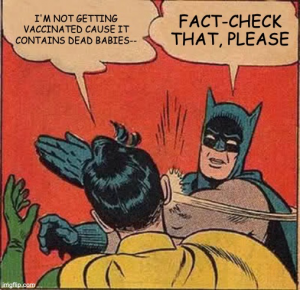Of the Origin of Flu, Poxes and Other Pandemics that Haunted Us (Part 1) – Ancient Diseases

Source: #19212 [https://phil.cdc.gov/Details.aspx?pid=19212] by CDC. Public Domain. A man with leprosy lesions on the ear.
Edited by Carl Ivan Nimmo.
Before modern medicine, the Old World was seething with diseases that could not be effectively treated as medicinal knowledge and techniques had not advanced sufficiently to treat these ailments. In these times, doctors or quacks practised bloodletting, inducement of vomiting and herbal treatments in the hope of at least alleviating the symptoms.6 As diseases were often seen as a punishment from God for misbehaviour, many turned to prayers and even flagellation as signs of penance to be cured.4 In this article, I will take you on a tour of the diseases that have been mostly eradicated from the Earth. I used the term “mostly” because you will never know if there are any reservoirs of the bacteria or virus in the wild, sometimes even frozen in the ice waiting for us to introduce it to the world again.
Leprosy (Hansen’s Disease)
Once roamed the land of the ancient middle east, Leprosy is a disease associated with sins in the Holy Book of the Christians.4 Often referred to as the “white sickness” due to its distinct work of discolouration of the lepers, leaving silvery white-coloured dry scales that cover what was once healthy human skin.4 Now, with the advancement of medicine, Hansen discovered the bacteria behind this disease.4 Invasion of Mycobacterium leprae often results in deformation of the face and digits due to damage to the nerve, cartilage and bones.4
Identification of the causative bacterium subsequently leads to the development of an antibiotic regime known as Multidrug Therapy (MDT) which consists of rifampicin and dapsone, with the addition of clofazimine in cases of multibacillary leprosy.3 The emergence of the treatment for leprosy has saved many from the stigma and hence eliminated the need to wear a bell or clappers to warn people of their approach or stay in a “lazar house” permanently – a predecessor of a quarantine centre.6
The Black Death – Bubonic Plague
The Black Death is probably the worst nightmare in the middle age (late 5th to the late 15th century).4 It went by many names, among them being “The Pestilence”, “The Justinian Plague”, and “The Great Mortality”.4 The zoonotic Yersinia pestis, discovered by bacteriologist Alexandre Yersin (1863-1943), was related to the Bubonic Plague in the 14th century.4 Another French bacteriologist Paul-Louis Simond (1858-1947), found out that the plague was probably carried by the fleas X. cheopis on rodents, hence the name rat plague.4 Direct contact with infected tissues will spread the disease as well.9 When the bacteria is inhaled, a less common but more lethal form, the pneumonic plague, will infest itself in the host.9 The buboes formed due to infestation of the bacterium in the lymphatic system, resulting in swelling of the lymph nodes, which may burst with blood and pus oozing out of them.9 As the bubonic plague spread like fire by the sea trade, the practice of quarantine arriving boats and ships emerged as there was no cure for the deadly infection at that time.4
“At the beginning of the malady, certain swellings, either on the groin or under the armpits…waxed to the bigness of a common apple, others to the size of an egg, some more and some less, and these the vulgar named plague-boils.” – Giovanni Boccaccio, Italian poet.4

Source: #14280 [https://phil.cdc.gov/Details.aspx?pid=14280] by CDC. Public Domain.
Anthrax
The rod-shaped bacteria bacillus anthacis lives in grazing animals primarily, causing massive damage to the food industry.4 Robert Koch, a German bacteriologist, discovered the causative agent of anthrax. He was, during that period, a rival to Louis Pasteur in France. Both gentlemen were racing to come up with more breakthroughs in the microbiology field.4 Humans can get infected by consuming infected meat, contaminated open wounds and inhaling air-borne spores.2 However, it cannot spread from human to human.2
The name “Anthrax” comes from the Greek word “charcoal” or “ruby”.4 The virus got its name from its ability to cause infected carcasses to ooze dark, viscous blood from the ruptured skin.4 Infected humans or animals commonly developed a black, necrotic sore in the form of a carbuncle.2 Anthrax still exists in certain areas, but thanks to the discovery of the anthrax vaccine, the spread of the disease are under control. Through painstaking experiments, Louis Pasteur found the perfect temperature to produce a suitably attenuated virus for the vaccination.4 On a side note, Pasteur is also the founder of the pasteurization process of milk and other products.4
Sadly, anthrax has gained popularity by exhibiting the great potential to be a biological weapon as it has a short onset and is highly lethal.1 Fortunate for humanity, the use of biological weapons was prohibited after World War 1, so there is no need to rush for an Anthrax vaccination right now.1

Source: #1934 [https://www.cdc.gov/anthrax/symptoms/index.html] by CDC. Public Domain.
Poliomyelitis
Poliomyelitis, or polio, reared its ugly head in the early 19th century (at the same time, smallpox was also rampaging globally).4 Started with flu-like symptoms that go away after a few days, paralysis and meningitis sometimes follow in certain people as the virus travels to the spinal cord from the throat and intestines.4,5 One contracts polio by consuming contaminated food; rarely, people catch the virus by inhaling the droplets.5 Polio is a selective virus that only survives in the human body.5 The fact that an animal reservoir of the poliovirus is not possible has made the eradication of polio in the human population an exciting challenge at that time. Consequently, two variants of the polio vaccine were developed in America, the inactivated shots by Jonas Salk and the orally administered live-attenuated polio vaccine by Albert Sabin.4
The Global Polio Eradication Initiative (GPEI) rolled out in 1988 has eradicated 100% of polio cases, or so they thought.7A 0.1% of poliovirus (the wild type) survived the mass vaccination and reemerging in Afghanistan and Pakistan since 2019.7 Similar cases were reported in Sabah, Malaysia in the same year.8 The news of polio making its comeback in 2019 was drowned by the word of the COVID-19 pandemic, slowing down the initiatives to contain it effectively as nations focus their effort on combating COVID-19.

Source: File: Child with infantile paralysis walking on hands and feet (rbm-QP301M8-1887-539a~4).jpg. [https://commons.wikimedia.org/wiki/File:Child_with_infantile_paralysis_walking_on_hands_and_feet_(rbm-QP301M8-1887-539a~4).jpg] by Eadweard Muybridge, 1884/1886. Public Domain.
What it all means to a pharmacist?
Community pharmacy has long acted as a community health hub; hence equipping oneself with such knowledge will strengthen the public’s confidence in pharmacists’ ability to educate and share accurate information. As a retail pharmacist, I was confronted with various enquiries about rare diseases. Besides referring the patients, we could do more by relaying minimal but proper education for those in need.
References:
- Britannica, T. Editors of Encyclopedia. Anthrax [Internet]. Chicago: Encyclopedia Britannica; 2022 Sept 6 [cited 17/11/2022]. Available from: https://www.britannica.com/science/anthrax-disease
- Centre of Disease Control and Prevention (CDC). Anthrax [Internet]. Atlanta (GA): Centre of Disease Control and Prevention (CDC); 2020 Nov 20 [cited 2022 Nov 17]. Available from: https://www.cdc.gov/anthrax/transmission/index.html
- Centre of Disease Control and Prevention (CDC). Hansen’s Disease (Leprosy) [Internet]. Atlanta (GA): Centre of Disease Control and Prevention (CDC); [updated 2017 Feb 10, cited 2022 Nov 17]. Available from: https://www.cdc.gov/leprosy/index.html
- Martin S. Short history of disease. AL5 1 XJ: Pocket Essentials; 2015
- National Health Service. Polio [Internet]. NHS. [updated 2022 Sept 16, cited 2022 Nov 18]. Available from: https://www.nhs.uk/conditions/polio/
- Strathern P. A Brief History of Medicine: From Hippocrates to Gene Therapy. Constable & Robinson; 2005
- The Global Polio Eradication Initiative (GPEI). Endemic Countries [Internet]. Geneva: The Global Polio Eradication Initiative (GPEI); [cited 2022 Nov 17]. Available from: https://polioeradication.org/?fbclid=IwAR0kfeLKHCY_leoG6v38wYKnGYmTpOS32l6S8I1hbrzF45VpW3Iz6ezI_o4
- Two more polio cases were confirmed in Sabah, a month after Malaysia’s first case in 19 years [Internet]. The Straits Time. 2020 Jan 11 [cited 17/11/2022]. Available from: https://www.straitstimes.com/asia/se-asia/two-more-cases-of-polio-confirmed-in-sabah-a-month-after-malaysias-first-case-in-19
- World Health Organization (WHO). Plague [Internet]. Geneva: World Health Organization; 2022 Jul 7 [cited 17/11/2022]. Available from: https://www.who.int/news-room/fact-sheets/detail/plague#:~:text=Bubonic%20plague%20is%20the%20most%20common%20form%20of%20plague%20and,is%20called%20a%20’bubo’.








